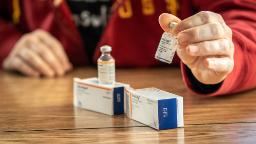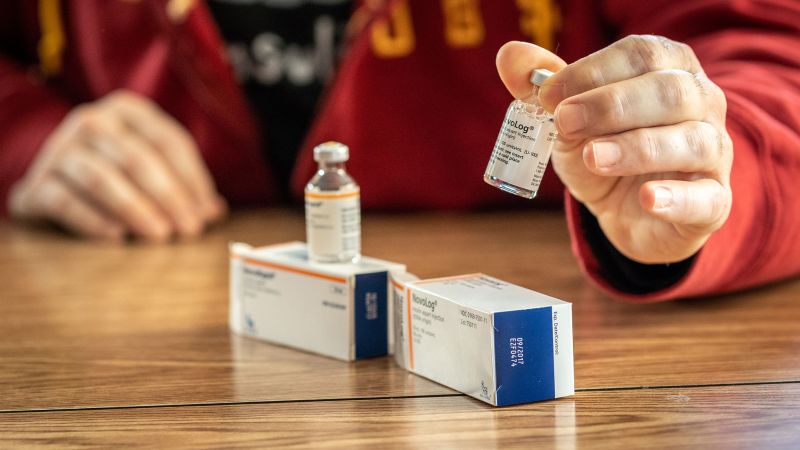
CNN
—
Novo Nordisk said Tuesday it will slash the list prices of several of its popular pre-filled insulin pens and vials by up to 75%, becoming the latest drugmaker to reduce the cost of the critical medicine for diabetes patients. The change will take effect January 1.
However, the company did not announce an expansion of its programs that cut patients’ out-of-pocket costs, which has been a focus of President Joe Biden and congressional Democrats.
Novo Nordisk’s move comes two weeks after Eli Lilly announced a series of price cuts that would lower the price of the most commonly used forms of its insulin by 70%. Eli Lilly also said it will automatically cap out-of-pocket insulin costs at $35 for people who have private insurance and use participating pharmacies, as well as expand its Insulin Value Program, which caps out-of-pocket costs at $35 or less per month for people who are uninsured.
After the reductions, Novo Nordisk’s NovoLog and NovoLog Mix 70/30 will cost $72.34 per vial and $139.71 per FlexPen.
Also, the company is lowering the list price of Levemir and Novolin by 65% to $107.85 per vial and $161.77 per FlexPen for Levemir and to $48.20 per vial and $91.09 per FlexPen for Novolin.
Novo Nordisk is reducing the price of two unbranded insulin products to match the lowered price of the corresponding brands as well.
Reducing list prices generally helps lower costs for insured Americans who have not yet met their deductibles and for the uninsured. Once the insured have satisfied their deductibles, they typically pay a lower price that is set by their insurance plan.
The price cuts have been in development for many months, but Novo Nordisk accelerated its announcement due to increased stakeholder interest, said Allison Schneider, the company’s director of media relations.
“The goal is for our collective programs to help more and more people better afford their insulin,” she said.
The high cost of insulin, which is relatively cheap to manufacture, has been in the spotlight for many years.
Last year, congressional Democrats passed the Inflation Reduction Act, which reduces Medicare beneficiaries’ out-of-pocket cost for insulin to $35 per month per prescription starting this year. Republicans blocked a measure to extend that price cap to those covered by private insurance.
In his State of the Union address last month, Biden called for capping the cost of insulin at $35 a month for all Americans. And he praised Eli Lilly’s move, describing it as “a big deal,” and calling on other drugmakers to do the same.
Novo Nordisk runs several programs to reduce the cost of insulin for diabetes patients, including a longstanding program that provides human insulin for about $25 a vial at Walmart. It is also available at CVS for $25.
The company also offers co-pay savings cards that allow eligible patients in commercial insurance plans to pay as little as $25 to $35 for several insulin products. And in 2021, it created My$99Insulin, which provides a 30-day supply of a combination of insulin products for $99.
The American Diabetes Association said it is pleased that additional manufacturers are moving to make insulin more affordable.
“We hope others follow suit,” said Lisa Murdock, the association’s chief advocacy officer.
At least 16.5% of people in the US who use insulin report rationing it because of cost, according to the US Centers for Disease Control and Prevention.
The average price of insulin nearly tripled between 2002 and 2013, the American Diabetes Association says. The trend has continued, with the average retail price of insulin rising 54% between 2014 and 2019, according to GoodRx, which tracks drug prices, provides coupons and operates a telemedicine platform.
Demand for insulin has grown significantly as diabetes has become the fastest-growing chronic disease in the world, a 2022 study found.
In the US alone, the number of adults with diabetes has doubled over the past 20 years, and more than 37.3 million people now have it, according to the CDC. Another 96 million Americans – 38% of the population – have prediabetes, a condition in which blood sugar levels are higher than normal but not high enough for a diagnosis of Type 2 diabetes. This can often lead to diabetes.
People with diabetes rely on insulin because their bodies have stopped producing enough of this hormone or aren’t using it efficiently to convert food into energy.
When a person eats, the individual’s body breaks down food, mostly into sugar. This sugar enters the bloodstream, and that signals the pancreas to release insulin, which works like a key that allows the sugar to energize cells. But if diabetes keeps sugar in the bloodstream for too long, it can lead to serious problems like kidney disease, heart problems and blindness.
In 2019, diabetes was the seventh leading cause of death in the US, according to the American Diabetes Association.

